Even though the penalties for exceeding fleet emissions quotas have essentially been waived, electrified cars are still going to happen. Many have been in development for years, so why change plans just short of the finish line? In that spirit, Jeep just released what sure seems to be the first official photo of the range-extender hybrid Grand Wagoneer 4xe. There’s a lot to dig into here, but first, we need to talk about the updated styling.
Since brevity is the soul of wit or whatever, Jeep has dropped just one photo, no information other than that it’ll arrive later this year, and you know what? That’s still enough to form an opinion. This leering, aggressive facelift is exactly what the Grand Wagoneer needed.
Look, this current full-sized Grand Wagoneer (pictured below; only offered with a gas engine) has never been a tasteful vehicle. Sure, it can be equipped with plenty of wood and a McIntosh audio system, but that’s like putting a Louis XV daybed and a Steinway in a McMansion. The overall wrapper is still ostentatious in a somewhat gauche way, and in an era of conspicuous consumption, the easiest way to enhance the visual impact is to double down on the original statement.
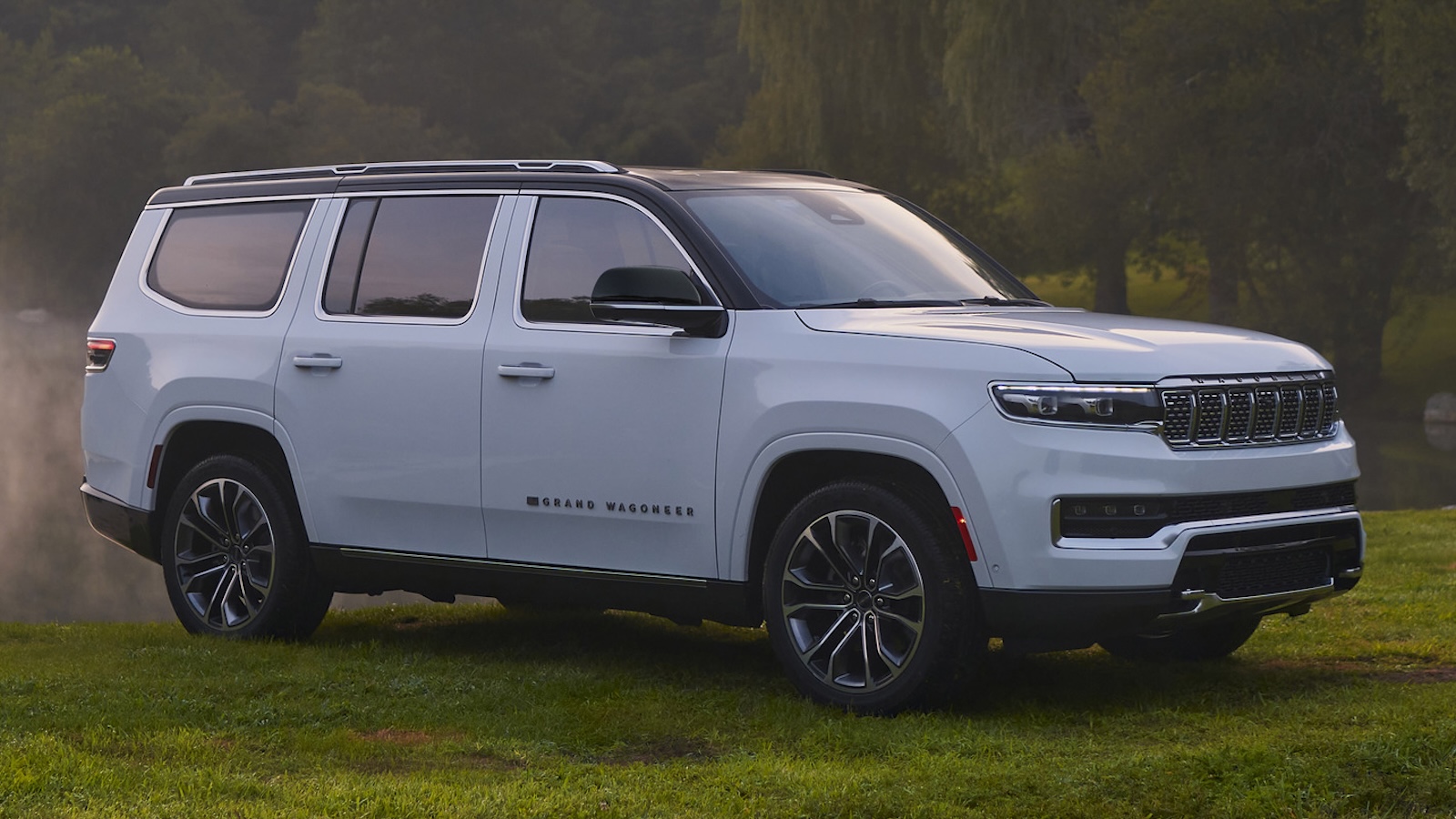
To that point, Jeep’s shrunk its seven-slot grille and fitted a massive, uninterrupted trapezoidal lower grill to really make the 2026 Grand Wagoneer look like it’s leering at you. Not only does it draw your eye away from the still-questionable pillar treatment, it manages to be both polarizing and well-executed. The modest and the Jeep-faithful will probably hate it, but the sort of people used to Escalades will probably like it.
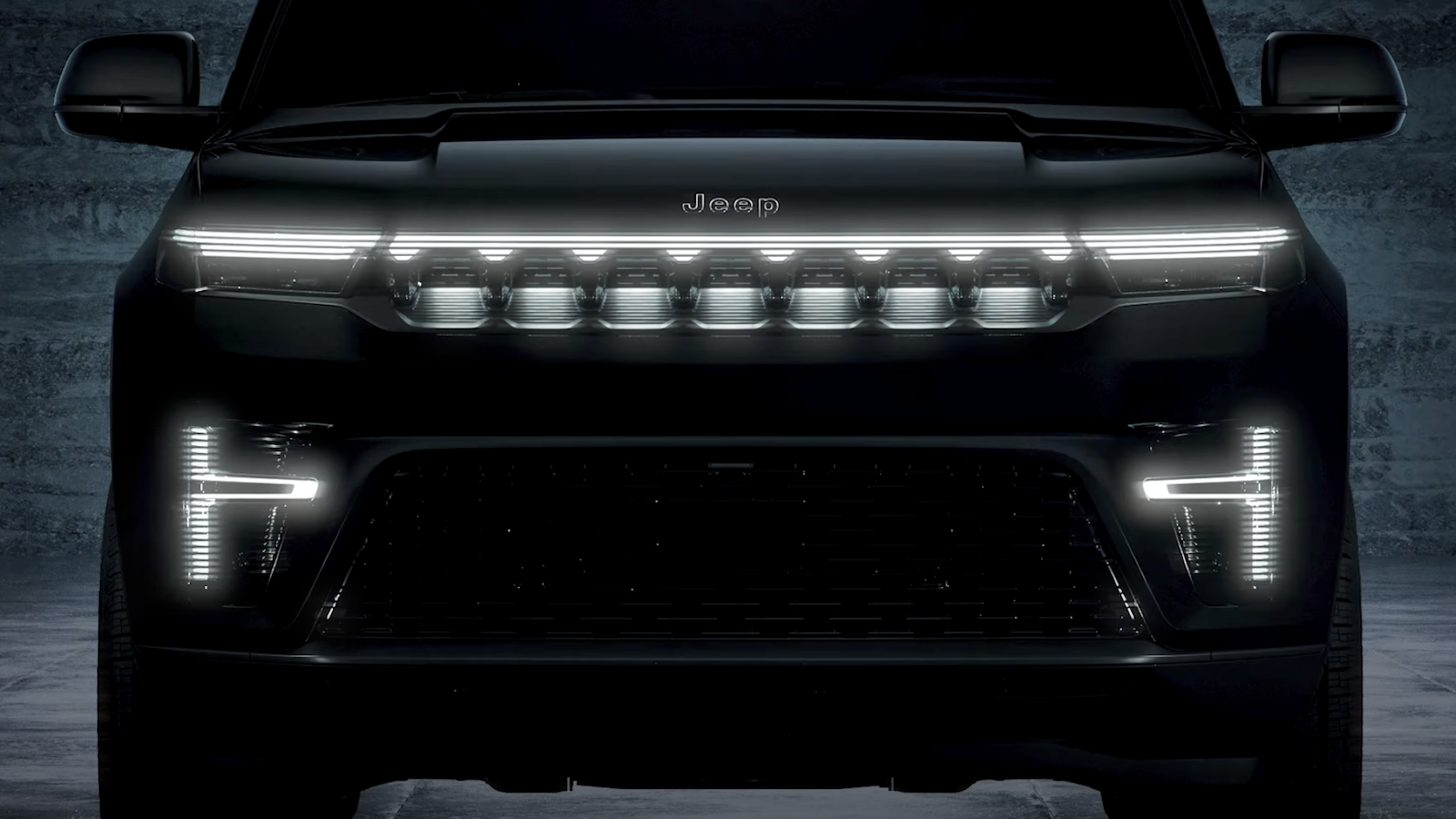
More than that, turning the seven-slot grille into a sort of faux-grille waterfall lighting piece builds a familial link with the electric Wagoneer S (pictured below), an olive branch the battery-powered midsizer needs. At the moment, it looks a bit like a Jeep but not especially like a Wagoneer, so updating the Grand Wagoneer to match is a prudent way of carrying some DNA upmarket. Since it’s not like the Wagoneer S has been a top-seller, it’s the sort of move Jeep can afford to make, and I reckon it’ll work on the whole.
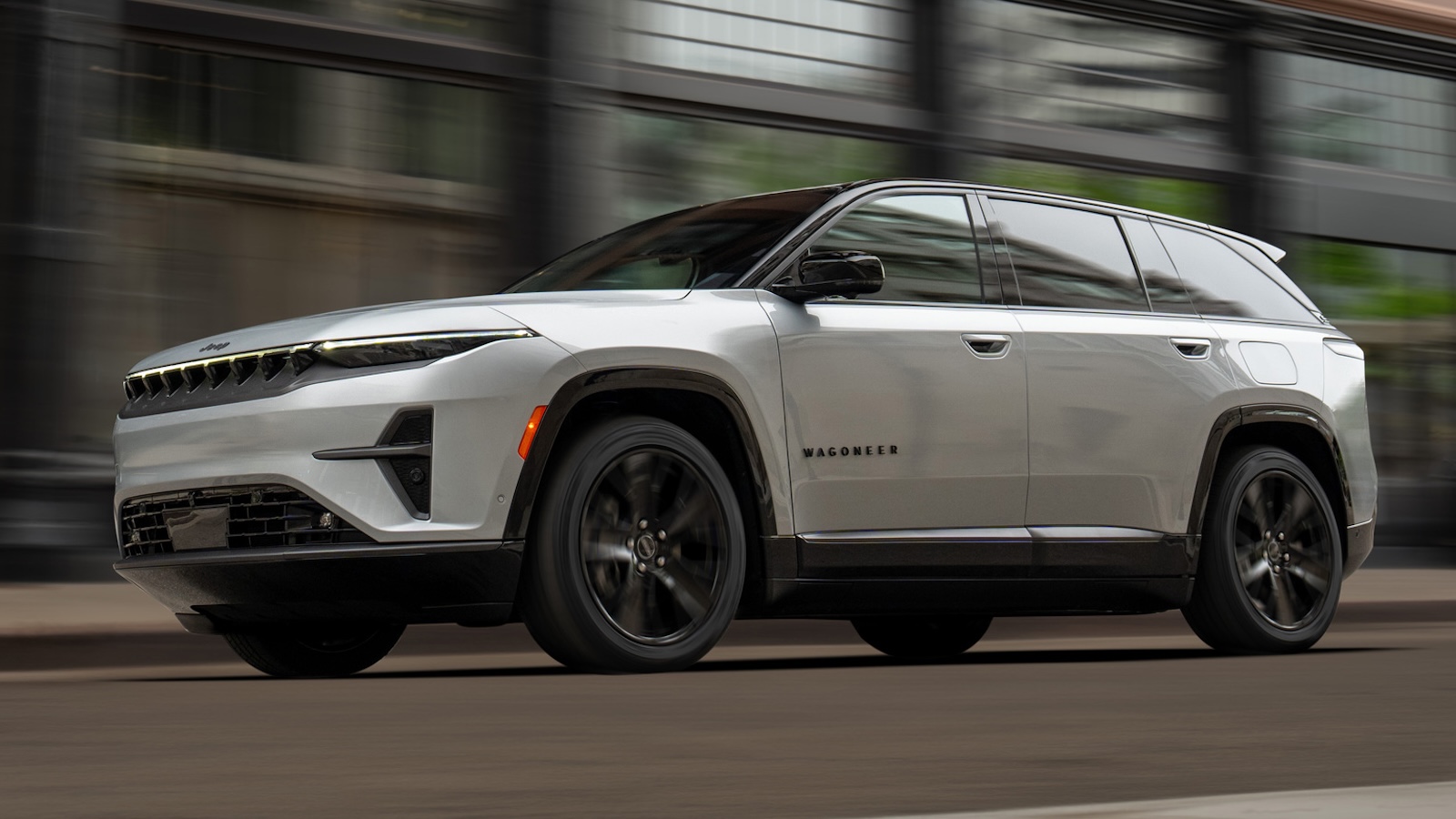
As for other details about the facelifted Jeep Grand Wagoneer, the brand isn’t officially saying anything, but there are some huge guesses that can be made from this teaser image featuring curious eight-lug hubs and what appears to be a charging flap in the front fender. We already know that the Grand Wagoneer shares a degree of commonality with the Ram 1500 pickup truck. That truck normally doesn’t come with eight-lug hubs unless it’s an electrified model. Could this be Jeep’s way of announcing that the long-awaited Grand Wagoneer range-extender hybrid first announced in 2022 is finally on its way? I reckon it very well could, as some degree of electrification is the only way some details on this official rendering make sense.
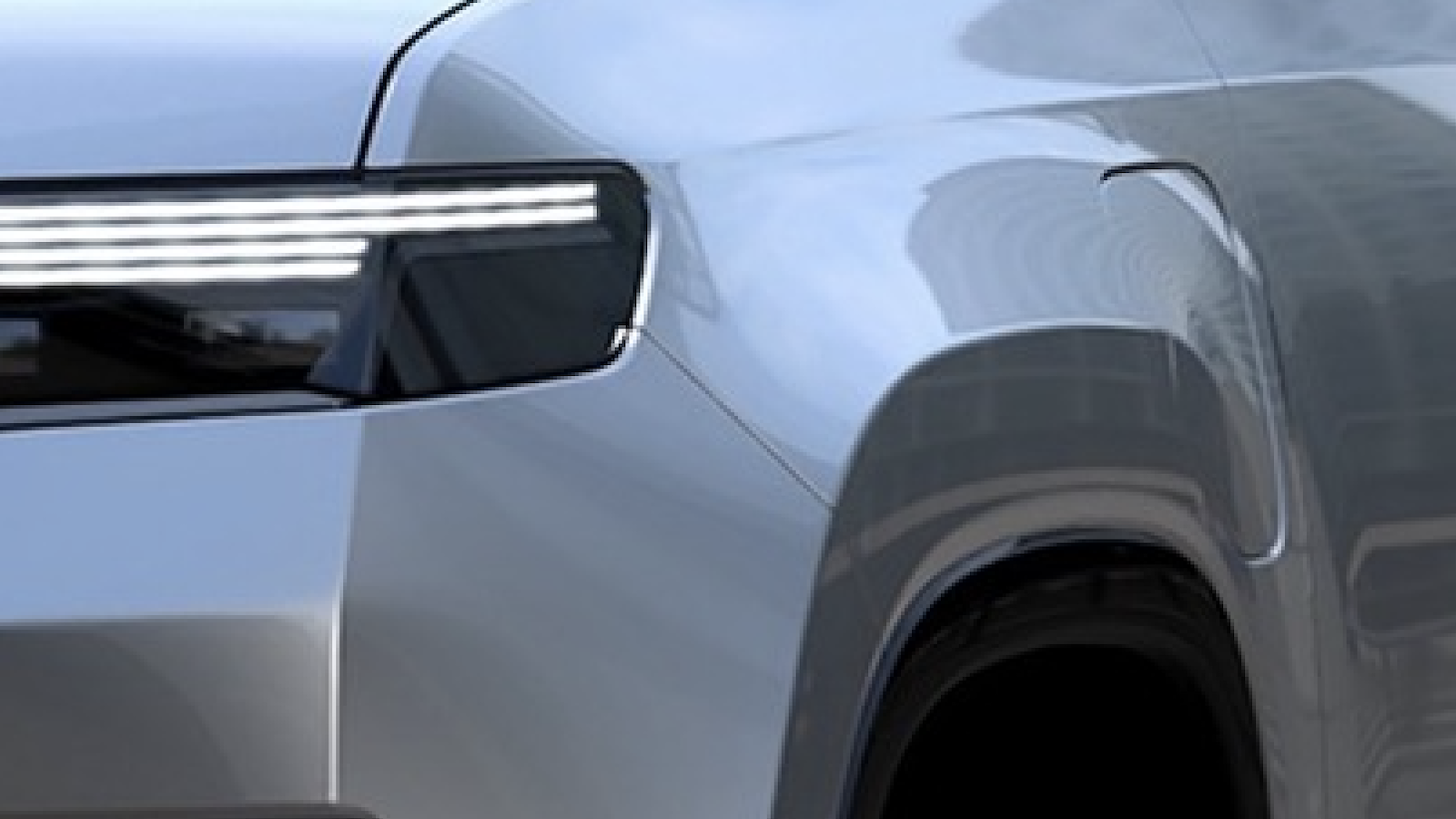
If the Grand Wagoneer does end up using the Ramcharger’s range-extender hybrid powertrain, expect a huge battery pack under the floor for seriously usable range, then a 3.6-liter naturally aspirated Pentastar V6 as a generator for when you’re out of juice. It would be a smart play considering the hybrid full-size body-on-frame SUV segment is essentially wide-open, and having an onboard generator is a huge plus over something like a battery-only Escalade IQ if you’re someone who tows frequently. Considering Jeep announced plans for a Wagoneer 4xe range-extender hybrid last year, this sure seems like our first official look at it.
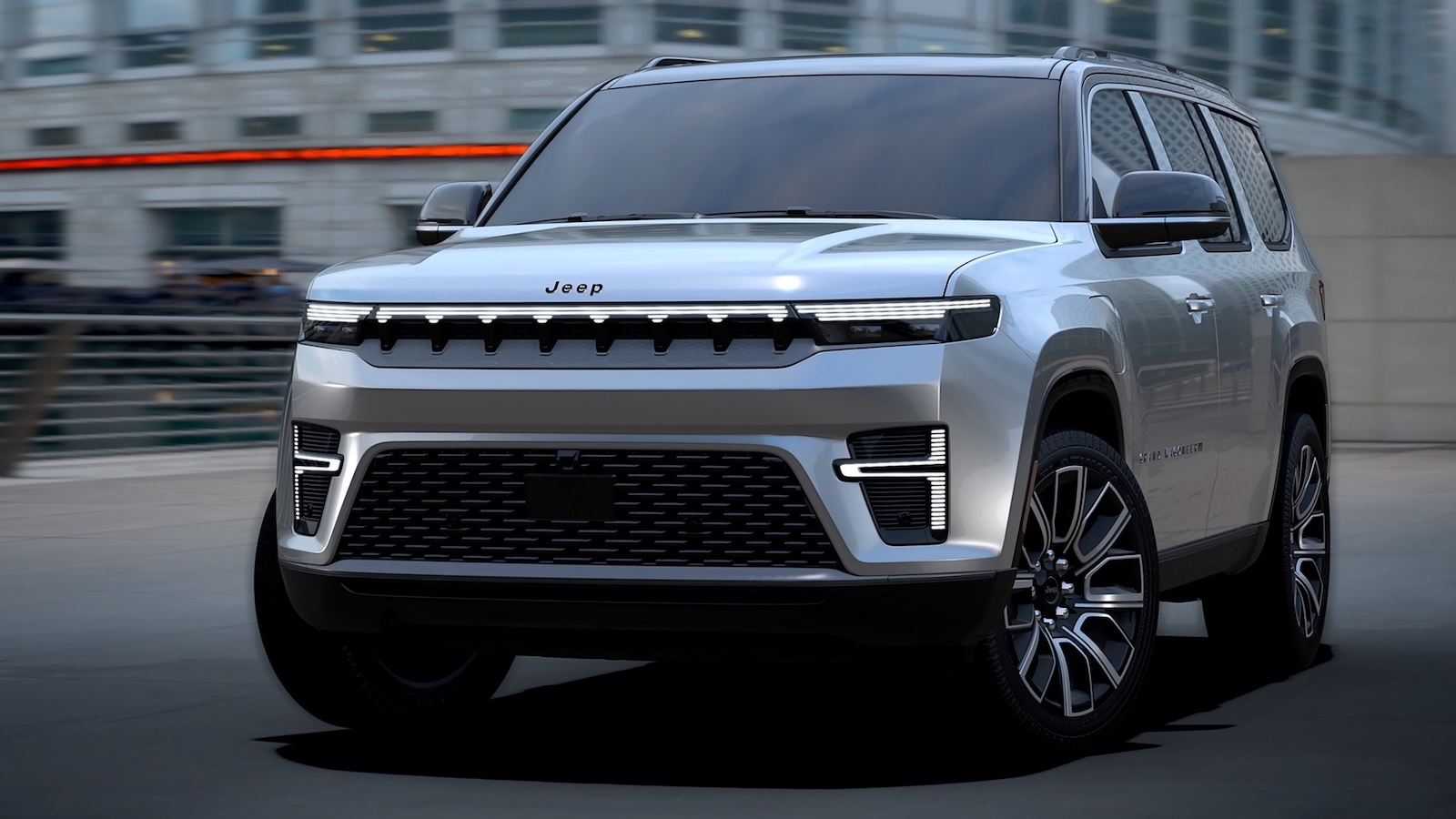
So yeah, the new Grand Wagoneer leans into the archetype it’s always embodied, and that commitment to the bit actually makes it look less frumpy. Plus, it’s looking like it’ll offer a range-extender hybrid powertrain, which would go a long way to alleviate the complaints of thirst that this model’s always elicited. Needless to say, we’re excited to learn more about what’s under the hood. Battery pack sizing, official EPA range, everything. All in due time, right?
(Top graphic image: Jeep)
Support our mission of championing car culture by becoming an Official Autopian Member.

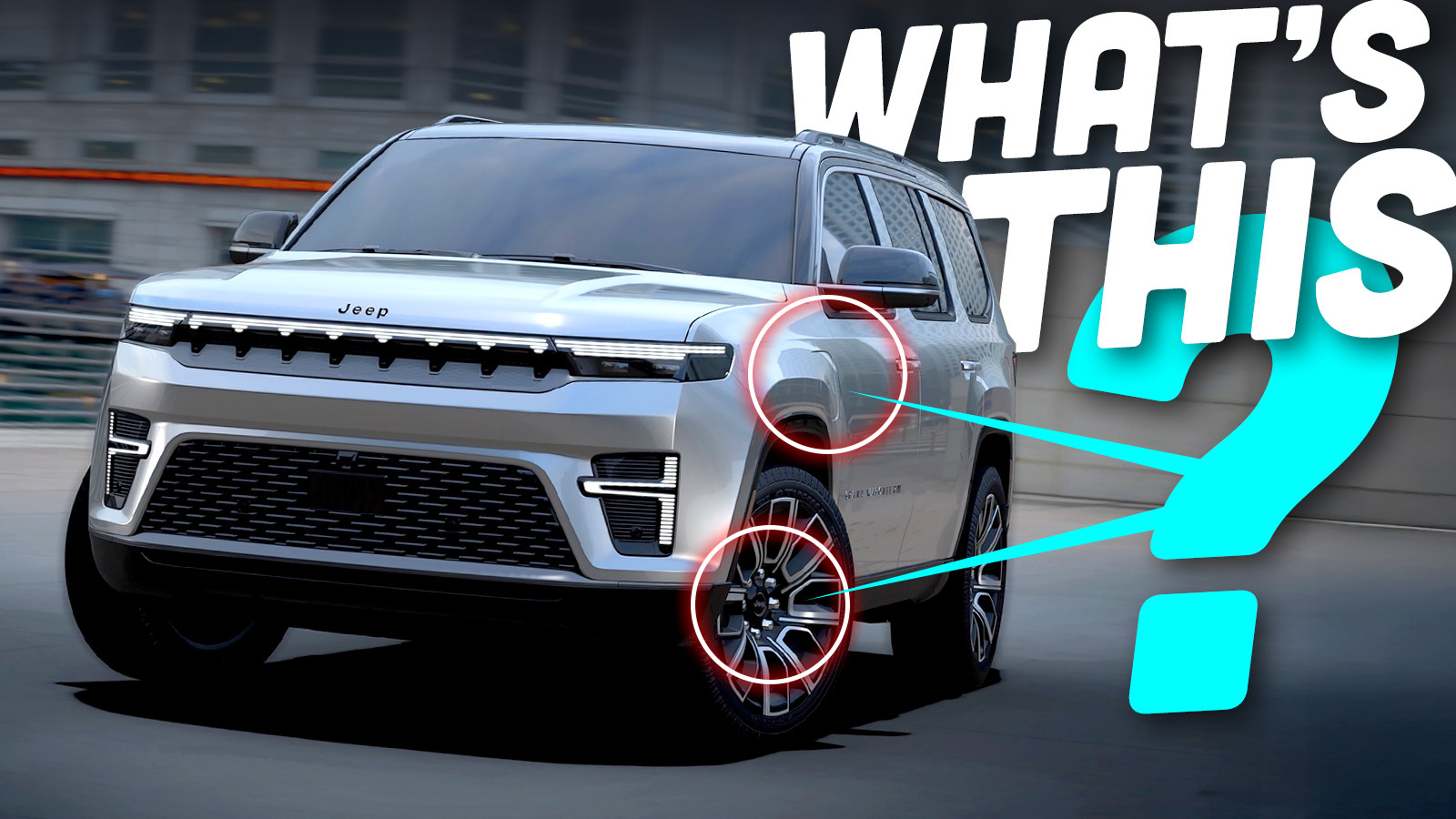







In a lot of other comments, the perennial “but EVs suck at towing trailers, you at least been a range extender ” is playing out.
If you need to pull a trailer sometimes, but not enough to justify a dedicated tow vehicle, why not build the range extender into the trailer?
Then you aren’t lugging around a range extender with all the added weight and complexity which requires added battery weight and a whole spiral of added weight ad nauseam.
I
I feel like you should just drive an ICE car if you need an EV with a V6 strapped to it. Also, imagine the reliability issues this will surely have.
The point stands that a PHEV in this segment would be amazing. Currently, only Mazda, Lexus & Volvo have three row PHEV’s (RIP Lincoln Aviator Grand Touring), and all of those are CUVs, not a truck-based Canyonero like the Wagoneer.
Nobody wasn’t buying the Wagoneer because of the grille.
And nobody wants another 9000 lb, barn shaped, SUV
How heavy is this thing going to be with batteries added?
edit: NM, I thought you were saying it was 9000 now which I would believe 🙂
RE: The headline image.
First guess is AI slop marketing material. I seriously doubt this thing is 8 lug (the image suggests possibly more, hence AI slop accusation).
Second guess is STLA is incapable of making an EREV that weighs less than 9000lbs. This is probably an equally likely outcome.
Slop? No, this is just the Wagoneer version of the Ram EREV which has been shown with 8 lugs already. The Wagoneer is already basically on the Ram chassis and would make sense any effort they put into the Ram EREV would be similarly applied to the Wagoneer.
Also, lug count isn’t just a function of weight; it’s also a function of power and towing capacity. I could easily see Stellantis trying to go after crazy towing numbers since this will the sole EV that doesn’t have range issues when towing.
Well today I learned the Ram EREV is 8 lug. Checks out that this thing is based on it as well.
I wish first owners and service depts the best of luck!
I’m sure the MSRP will approach what a small house in a small town costs.
Considering its the size of a small house….
It looks better, but the front end wasn’t what I had big complaints about to start with. It’s the weirdo pillars.
The old front end is better. If we are being honest.
I like the old grille more, but this front end seems more cohesive as a whole. Maybe throwing the old grille and headlights, with the lower portion of the new one would be best. I dunno.
Nailed it. The front end styling was fine, while the side profile looks like a school bus with the windows mounted upside down, and the rear looks like one of those RVs that uses off-the shelf tail lights from some discontinued sedan.
Stellantis designers: “guess we should change the front end!”
So…this is an EREV….with a V6 Pentastar as the generator?? Why would you do that? I would get it if it was a PHEV and the V6 actually powered some wheels, but as a battery charger it would be way too big and thirsty.
The idea that EREVs can get away with tiny engines is a fallacy. The ICE engine needs enough output to maintain acceptable speeds, while towing max capacity under adverse conditions with an empty battery.
The disconnection of the engine from the wheels actually increases the loading in this scenario, as now you have to compensate for power generation losses.
Tiny EREV engines only work if drivers tolerate the vehicle going into ‘limp mode’ after the battery is depleted. That’s not going to fly for a truck with a 10,000-14,000lb towing capacity. The other option would be to kick the generator on early, but then you’re defeating the win of electric-only driving under most conditions. Might as well ditch the massive battery, and build a regular hybrid.
The Scout EREV gets around this by slashing its towing capacity in half vs its pure EV counterpart.
You’re suggesting an EREV that operates like a true parallel hybrid–the electric motors powering the wheels could be supplied with power from EITHER the engine/fuel or the battery. That has some cool advantages, but I was thinking more of like a series hybrid, where the generator only supplements the energy provided by the batteries. When I think “range extender”, this is what my mind imagines. Because I think “parallel hybrid” with your scenario.
I don’t know what scheme most EREVs use–they’re still new and I haven’t researched them much.
The ICE power plant in an EREV needs to be able to output decent power. If it’s super small, it’s going to be running all the time and only really trickle charging the battery and basically make the whole EV portion pointless since it will be continually burning gas. It has to be large enough to actually charge the batteries while those batteries are also being depleted moving the vehicle. Basically the peak output of the ICE power plant needs to exceed the average output of the EV system, plus some safety factor for instances like pulling a trailer or long uphill highway climbs.
Plus, as much as I rag on the Pentastar, I’m sure it’s probably actually decent for this. It almost certainly has been heavily modified to run at a very small, yet highly efficient, RPM range than a normal one, and probably sacrificed peak numbers since that doesn’t matter quite as much here.
My take is, that this depends entirely on how big the battery is. If the battery is big (I’m talking 300+ miles of EV range alone), then I’d be perfectly fine fine with a small gas engine that can’t fill the battery as quickly as it depletes. If over the 300 miles of range, it only manages to fill an additional 150 miles, that still means you’ve got 450 miles of range (well, actually more, because while you drive that 150 more miles, you’d get another ~75 generated).
The only downfall would be that if you reach a point where the battery hits zero, you need some way directly drive the wheels with the gas engine at some point. Or you risk limping to a charger (or sitting idling to charge the battery).
The problem with your thinking is if it can only charge 150 miles worth of range during 300 miles of EV consumption, you’ve got to have that ICE engine running basically full throttle as soon as you start your trip. That doesn’t make for a good experience and doesn’t make for all that much gas savings either since you’ll always be using the gas engine. If you instead have a larger engine, you can wait much longer to kick it on and when you do, you can have it operate for peak efficiency before you have to transition to peak output.
450 mile road trips are relatively rare for most vehicle owners. And why full throttle? Properly size it and tune it and spec it, and it should be humming along at a reasonable rate. No range extender is programmed/tuned to run full throttle.
And this would be a user selectable thing. If you plan on driving less than 300 miles, just have it run in just EV mode, where you can then charge at your destination.
By your own (badly designed EREV) constraints, it would need to be at max output to charge the 150 miles. Max output is what I meant by “basically full throttle”.
And you’re missing the point that if you have a car that can already manage 300 miles of EV range alone, it’s probably not well designed EREV to begin with. There is a reason most proposed EREVs are only meant to get like 100-150 miles of EV range yet can still manage 400+ miles of total range. You get to save on the cost of batteries while getting highly efficient EV driving for the normal day to day stuff – yet you don’t get range anxiety for those long trips. They only really make sense if the ICE engine output can exceed the average EV output. If you can’t use the ICE engine to truly charge the car, you still end up with range anxiety and are forced to find a charger. If you can already fit enough batteries for 300+ miles of range as well as a full ICE powerplant and gas tank and what not, why not just get rid of the ICE stuff all together and add some more batteries and have people stop to charge for your relatively rare 450+ mile road trip? You’re scenario would be much better fit by a PHEV or normal hybrid if you basically want the engine operating at all time there isn’t a need to be carting around such large batteries.
I’m wrong for thinking of a range extender as something that… extends the range?
If your car is going to get most of it’s range from the gas engine, that sounds much more like a PHEV to me, than a range extender.
I think these are not ment to be “range extenders” like Davids bmw, but have adequate power to run the vehicle for long distances (possibly towing) without the need to recharge.
EREVs (Extended Range Electric Vehicles) are just a new name for a PHEV.
The 2026 Ramcharger is a series hybrid that has an electric range of 145 miles (EPA combined). It has a 271 hp V6 because that is what is needed to keep it going highway speeds while towing once the battery depletes.
We’re delving into semantics here, but I don’t think that’s the case (according to current definitions). Granted, the actual words “plug-in hybrid electric vehicle” apply to an EREV, but an EREV is a vehicle designed as an electric vehicle first and gets (supplemental? replacement? series/parallel?) power from another source (ICE). The ICE does not directly power the wheels.
Conversely a PHEV generally is a vehicle that allows for the ICE engine to directly drive the wheels (in series or parallel with the electric motors).
In a PHEV, the batteries/motor assist the ICE/fuel, in an EREV, the ICE/fuel assists the batteries/motor.
I guess the difference to me (until marketing changes) is whether the wheels are directly driven by the engine or not. Does that ICE need a transmission and power the wheels?: PHEV. Does that ICE just act as a generator?: EREV.
You can make that distinction if you want. To me nothing with an ICE is an EV.
I think your feelings are getting in the way of reality. This Jeep is going to be a Ramcharger in a different skin. That car can just be driven like a regular car if you choose to do so, i.e., never plugged in. The power management system will ensure that the generator 3.6 kicks on while there is still plenty of reserve battery to keep driving the wheels. And there’s no question that a 3.6 can put out enough power to keep driving the car (that is, keep the battery powered up) as long as there’s gas in the tank.
https://www.ramtrucks.com/electric/ram-1500-ramcharger.html
the real issue is the marketing depts calling these things EVs at all, which they aren’t. They are plug in hybrids, although, thankfully in my opinion, with enough battery to really do most non-towing or non-road trip driving on electrons.
Thanks for the press release, it actually tells me all I need to know. It sounds mostly like my Volvo XC90 T8, with the exception that the ICE is only a generator–so it IS an EREV–it has an electric charging port but the engine acts only as a generator.
It lists a “combined” HP rating, which means that, just like my Volvo, you can have BOTH the ICE and the motors on at the same time, activated either by press of the throttle or by a low state of charge. It probably has the same drive modes, which will let you either maximize battery consumption (engine off) or maximize power (both power sources on).
Nice Volvo! Love that! Thanks for pointing out the “direct drive” mode, kind like diesel-electric locomotives. That’s a cool way to max out the generator/3.6 while also having some juice from the battery on tap for acceleration/big hills etc.
The Scouts have ~350 electric range, with a ~500 mile total range. Very close to my argument…
I think you’re confusing both the full EV Scout and the EREV Scout. Yes, the EV scout gets ~350 miles of range and the EREV gets 500 miles total range; yet the EREV only has about 150 miles of BEV range with the rest coming from the REx portion.
Yeah. That downfall is critical. You either end up with ‘limp mode’, or have to run the generator constantly.
The downfall isn’t that bad. You’re total range here would be just short of 600 miles.
Having to run the generator constantly to achieve max range doesn’t seem all that bad. How frequently are people using the maximum range of their vehicle? And if they are doing it a lot, then this isn’t the vehicle for them.
Sizing the engine to out-compete the battery for charging seems like a total waste of resources. Hell, the i3 REV is like the worst case scenario for my argument, and I’m simply suggesting a larger battery (and slightly higher) charge rate than that (comparatively speaking).
You are forgetting about towing. An electric truck with a 300 mile range going to tow 100 miles or less. (Motor Trend got 90 miles with their Lightening (310 mile range))
When the battery goes flat it need to be able to continue towing max GCWR at highway speeds AND go that 500 miles. That takes either an absolutely massive battery or an engine sized for the load. Ram when with the later option as a V6 pentistar is MUCH cheaper than hundreds of kWh of battery and much lighter as well.
The idea is to have a vehicle that can do almost all around town driving on electric AND tow 500 miles on the highway.
Not every EREV needs to be able to do that…
No, but we are talking about vehicles with 10,000 to 14,000 tow rating.
How many buyers actually use them for that? I have yet to see a Wagoneer or Grand Wagoneer towing anything at all.
We’re talking about EREV’s. If you really want to tow, just buy the ICE.
Buy the ICE and get 16 mpg driving around town where you spend most of your miles instead of the equivalent of 80 mpg? Do that instead of getting 22 mpg instead of 25 mpg when doing highway trips with the PHEV?
You are also forgetting that CARB states are rapidly phasing out pure ICE vehicles and making PHEV vehicles the minimum. Large SUVs and trucks are the perfect application of PHEV technology in a regulatory environment that is rapidly moving to pure EV.
You keep conflating PHEV and EREV as if they are the same thing… they aren’t.
EREVs are electric vehicles, that have a range extending function.
We are just going to have to agree to disagree. Any vehicle with a ICE onboard is a hybrid.
No such downfall on this specific platform though! When you are doing around town and regionally, you are good on 100% electrons. When you are towing or driving all day/night, you run as a hybrid and get around 22 mpg. It runs the generator with enough reserve battery capacity that you never go into limp mode.
I think this is why the Ramcharger platform is such an exciting thing to a lot of folks who really want to actually drive only on electrons, but also really want an actually capable/zero charging stop tow and road trip vehicle. Which is a lot of people!
Ding, Ding, Ding – we have a winner!
I understand your point–I confess I don’t have a feel at how well ICEs would generate electricity (nor do I know the energy demand of a BEV), but it seems pretty obvious here that we get into real state of diminishing returns if you have to lug a full size 3.6L engine around that only ever gets used when a vehicle hits the end of its range. Lugging around that much weight for a seldom used long distance use case is not an efficient design imho. My supposition is that the ICE turns on at a point far earlier before the batteries are fully discharged and the engine’s supplied amperage would just be a supplement to the amperage provided by battery storage, not a total replacement for it. I think you and 86-GL are designing vehicle that could run entirely on empty batteries and generator power alone, and indeed that would likely require a much larger engine than one that’s just meant to supplement only a portion of the electrical output. There may be consumers who would demand such a design–i don’t really know.
Furthermore, if I’m designing the vehicle, I want that engine to be active on more use cases because that fuel in the tank will go bad. I have a 2016 Volvo XC90 T8 (PHEV) currently and even though I put it in electric-only mode all the time, it will turn on the engine against my will with a dashboard notification saying it’s doing so to use up aging fuel.
I think I would design a smaller engine that turns on at some mid or low point of battery state, until the batteries themselves are depleted, and then would act as a limp-home mode.
Motor Trend’s test Ford Lightening extended range (131 kWh / 310 EPA range) towed a small 8,000 lb travel trailer 90 miles.
That is what automakers are up against when they try to make an EV that tows.
At his point engines are cheap and light compared to batteries. It is far easier to pay for and package a V6 than a giant battery.
So the solution is to add another 600+ lbs and a full engine bay of components (and let’s not forget the 300lbs 40gal gas tank–engines are getting lighter, but fuel isn’t) to a truck that is already 6700lbs? For the (typically) rare use case of towing an 8,000lb trailer?
Sounds like the manufacturers have a real tough nut to crack if they want to try to supply consumers with an EV that can meet this towing use case. (At least in an efficient way…it seems like they are willing to supply it in an inefficient way, at least…). Seems pretty obvious to me that such a vehicle would not fare well against a traditional ICE truck.
The difference between a 1.5L or 2L and V6 isn’t 600 lbs.
Yes, you need an engine if you are going to tow with an EV – at least with current battery tech. The key used case for one of these vehicles is larger vehicles – especially Class 3 and above.
A PHEV truck is going to be more efficient that a plan gas truck. The key is to not load it up with a huge and oversized battery.
(Ford has hinted they are looking at a PHEV SuperDuty.)
I just said 600 lbs, not 600 lbs MORE than a smaller displacement engine. I can see why you thought that, however. The point still stands that a larger, more powerful engine and its fuel tank are going to add more weight to a hybrid design than a smaller, more fuel efficient engine.
My point here is about use cases with respect to the parallel hybrid you are advocating for–anytime you are fully using the ICE and not using the batteries causes those batteries to become dead weight and an increased load on the ICE. Likewise, anytime you are fully using the batteries and the ICE is unpowered causes that ICE to become dead weight.
So you’d want to maximize your design according to use cases. I’ll make a broad statement here about energy (fuel, battery charge) usage here: a BEV will be more efficient under a light load, and an ICE will be more efficient under a heavy load, correct? If I’m designing a hybrid vehicle where it will be used primarily under light loads 80% of the time and heavy loads only 20% of the time, then I would design a compromise vehicle that maximizes it’s use under light loads and minimizes the negative effects of the ICE engine that rarely gets used.
If you try and design the vehicle as a full parallel ICE (full size engine) and BEV (with full-sized batteries), you’d get a car that can function under both long range and towing conditions (it can do it all!)…but it would be very inefficient at both of those functions. It would swallow charge rapidly while the engine/fuel sits unused and it would swallow gasoline when the batteries are unused, because of the high overall weight.
Now as a consumer, if you aren’t concerned about energy prices and you just want one vehicle that co do everything, then this full parallel hybrid is your vehicle.
To make that whole system more efficient, though, you’d need to find a way to reduce overall weight. One method is to find some overlap in function between the ICE and BEV and make it a series hybrid–both the ICE and BEV would get used way more often and then you can reduce the weight of both. Or a parallel hybrid where (through programming) both functions are on at the same time–saves you some weight, but not as much as a full series hybrid. What you were advocating for is where there is NO overlap. I won’t go so far as to call that a poor design…but a very energy inefficient design, yes.
I do like parallel hybrids (I own a Volvo XC90 T8), and I agree with Volvo’s solution is to go heavy on the ICE and lightweight on the BEV. The battery is only good for 20-40 miles, which is enough for a daily commute (and i can go months without filling up). But the Volvo’s PHEV gives the ICE the responsibility for the extended range and increased load use cases. At 5000lbs, it’s not a lightweight…but it’s 37.5% lighter than an 8000lbs vehicle. But it also only has a 5,000lb tow rating. I never tow anything, though.
I think it’s a design mistake to try and provide a hybrid vehicle all its range with just the heavy batteries, because gasoline is better for that. Put a small battery for high frequency short trips and then use the fuel and the ICE for the long trips and towing. If you ARE going to add an ICE to a long-range BEV, make it as light as possible.
The 2026 Ramcharger is not a parallel hybrid. It is a series hybrid. The engine is not physically connected to the drive wheels.
The Ramcharger is also rated to tow 14,000 lbs – and need to be able to tow – at highway speeds – which simply requires a larger engine.
Personally I think the battery in the Ramcharger is a bit large but it may also need to be that large to get the 650 hp they are going for.
I guess we will have to see when the rating come out. I suspect the Ramcharger will be rated similar to the Hurricane SO running on the gas engine.
Lots of folks drive trucks, and commute a hundred or so miles a day. Yes, “most commutes are under 30 miles round trip.” But millions (tens of millions?) of people regularly drive over a hundred miles a day, in a pickup, for work. It may not always make sense, but its reality. Lots of those folks have the truck because they have something they tow and don’t have a budget that can support 3 or 4 vehicles. That’s the use case for this setup! Its all those people saying “I love EVs, but can’t buy one because I have to be able to tow my boat/camper/motorcycle/racecar to the lake/mountains/track on summer weekends, which is important to me and which I will not compromise on.” The other use case is construction folks who intermittently pull trailers and take varying distance trips all the time. Those are where this makes sense, and that’s what its for!
I fully agree with all your points and arguments. A pure BEV is best for light loads/passenger cars and trips under 300 miles or so! An EREV with a tiny engine to limp home on would be great for folks with the light loads who may not have great access to charging or may want to do some long trips! A heavy duty PHEV with a small battery sounds awesome for folks who are towing 80 or 90% of the time! And a PHEV like your Volvo sounds great for folks with short commutes.
But don’t say this Ramcharger type setup makes no sense! It makes perfect sense for its use case! It doesn’t have to make sense for the other use cases, because that’s not what it is for.
“ It almost certainly has been heavily modified to run at a very small, yet highly efficient, RPM range than a normal one,”
From what I’ve read, that’s exactly what’s going on. And also from what I’ve heard and read, the 4XE hybrid that uses a 4cyl turbo doesn’t get very impressive fuel economy once you’re in hybrid mode.
And in general, it seems that it’s better to have a larger displacement engine that is lightly stressed than a smaller higher-stressed engine.
Case in point… the F150 and the V8 vs the Ecoboost. When driven lightly, the Ecoboost typically gets better fuel economy. But if you haul/tow stuff all the time, the V8 will get better fuel economy in the real world.
I also imagine sound-quality plays a role… that Pentastar V6 probably has a nicer/quieter sound compared to the turbo 4 cyl used in the 4XE.
Mainly because its a ginormous truck that will require a ton of energy to move regardless of how its sourced. Same with the Ramcharger. It may be silly in a car, but not in this big dog! An NA 3.6 V6 is a fairly small engine for a serious tow vehicle. By running the 3.6 at an efficient rpm/load any time the battery drops below [insert value, but to maintain full capability, maybe something like 60%] the 3.6 kicks on to juice it up. Around town you never use the 3.6 at all. Excited to see what we get!
Thomas, did you somehow draw the short straw? Having to write anything at all about a Stellantis product is challenging, but this GWagoneer plus tomorrow’s Hellcat whatever-whatever reveal, dang you must have upset someone to be forced to write about these topics. I commend you for at least trying and doing a decent job of it.
If only Stellantis had an American brand to plop these luxury oriented SUVs into instead of slowly forcing Jeep into an identity crisis with vehicles not even pretending to look like soft roaders…. *camera pans to Chrysler*… crazy thought right?
Does it still have the same terrible aesthetic proportions of the current one?
…sure looks like it does.
It’s like they didn’t even fucking try with the styling of any of these new Wagoneers.